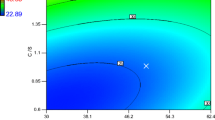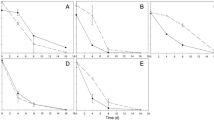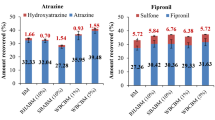Abstract
The ligninolytic fungus Trametes versicolor was employed in the bioaugmentation of compost- (GCS) and peat-based (GTS) biomixtures for the removal of the insecticide-nematicide carbofuran (CFN). Among several lignocellulosic substrates, fungal colonization was best supported in rice husk, and this pre-colonized substrate was used to prepare the biomixtures. Estimated half-lives for CFN were 3.4 and 8.1 days in the GTS and GCS biomixtures, respectively. The CFN transformation products 3-hydroxycarbofuran and 3-ketocarbofuran were detected at the moment of CFN application, but their concentration continuously decreased to complete removal in both biomixtures. Mineralization of 14C-radiolabeled CFN was faster in GTS (k = 0.00248 day−1) than in GCS (k = 0.00188 day−1). Complete elimination of the toxicity in the matrices was demonstrated after 48 days. Overall data suggest that the bioaugmentation improved the performance of the GTS rather than the GCS biomixture.




Similar content being viewed by others
References
Asgher M, Bhati HN, Ashraf M, Legge RL (2008) Recent developments in biodegradation of industrial pollutants by white rot fungi and their enzyme system. Biodegradation 19:771–783
Bending GD, Friloux M, Walker A (2002) Degradation of contrasting pesticides by white rot fungi and its relationship with ligninolytic potential. FEMS Microbiol Lett 212:59–63
Botterweck J, Schmidt B, Schwazbauer J, Kalathoor R, Schäffer A (2014) Enhanced non-extractable residue formation of 14C-metalaxyl catalyzed by an immobilized laccase. Biol Fertil Soils 50:1015–1024
Castillo MP, Torstensson L (2007) Effect of biobed composition moisture, and temperature on the degradation of pesticides. J Agric Food Chem 55:5725–5733
Castillo MP, Torstensson L, Stenström J (2008) Biobeds for environmental protection from pesticide use – A review. J Agric Food Chem 56:6206–6219
Chin-Pampillo JS, Carazo-Rojas E, Pérez-Rojas G, Castro-Gutiérrez V, Rodríguez-Rodríguez CE (2015a) Accelerated biodegradation of selected nematicides in tropical crop soils from Costa Rica. Environ Sci Pollut Res 22:1240–1249
Chin-Pampillo JS, Ruiz-Hidalgo K, Masís-Mora M, Carazo-Rojas E, Rodríguez-Rodríguez CE (2015b) Adaptation of biomixtures for carbofuran degradation in on-farm biopurification systems in tropical regions. Environ Sci Pollut Res 22:9839–9848
Coppola L, Castillo MP, Monaci E, Vischetti C (2007) Adaptation of the biobed composition for chlorpyrifos degradation to Southern Europe conditions. J Agric Food Chem 55:396–401
Coppola L, Castillo MP, Vischetti C (2011) Degradation of isoproturon and bentazone in peat- and compost-based biomixtures. Pest Manag Sci 67:107–113
Cruz-Morató C, Rodríguez-Rodríguez CE, Marco-Urrea E, Sarrà M, Caminal G, Vicent T, Jelić A, García-Galán MJ, Pérez S, Díaz-Cruz MS, Petrović M, Barceló D (2013) Biodegradation of pharmaceuticals by fungi and metabolites identification. In: Vicent T, Caminal G, Eljarrat E, Barceló D (eds) Emerging organic contaminants in sludges: analysis, fate and biological treatment, Hdb Env Chem. Springer-Verlag, Berlin, pp 165–213
Doddapaneni H, Yadav JS (2004) Differential regulation and xenobiotic induction of tandem P450 monooxygenase genes pc-1 (CYP63A1) and pc-2 (CYP63A2) in the white-rot fungus Phanerochaete chrysosporium. Appl Microbiol Biotechnol 65:559–565
Eggert C, Temp U, Eriksson KEL (1996) The ligninolytic system of the white rot fungus Pycnoporus cinnabarinus: purification and characterization of the laccase. Appl Environ Microbiol 62:1151–1158
EPA (2001) EPA-823-B-01-002 methods for collection, storage and manipulation of sediments for chemical and toxicological analyses: technical manual. Office of Water (4305), Washington, DC
EPA (2002) EPA-821-R-02-012 methods for measuring the acute toxicity of effluents and receiving waters to freshwater and marine organisms. Office of Water (4303T), Washington, DC
Font Segura X, Gabarrell Durany X, Ramos Lozano D, Vicent Huguet T (1993) Detoxification pretreatment of black liquor derived from non-wood feedstock with white-rot fungi. Environ Technol 14:681–687
Gao W, Liang J, Pizzul L, Feng XM, Zhang K, Castillo MP (2015) Evaluation of spent mushroom substrate as substitute of peat in Chinese biobeds. Int Biodeterior Biodegrad 98:107–112
Gupta RC (1994) Carbofuran toxicity. J Toxicol Environ Health 43:383–418
Kaal EEJ, de Jong ED, Field JA (1993) Stimulation of ligninolytic peroxidase activity by nitrogen nutrients in the white rot fungus Bjerkandera sp. strain BOS55. Appl Environ Microbiol 59:4031–4036
Kravvariti K, Tsiropoulos NG, Karpouzas DG (2010) Degradation and adsorption of terbuthylazine and chlorpyrifos in biobed biomixtures from composted cotton crop residues. Pest Manag Sci 66:1122–1128
McErlean C, Marchant R, Banat IM (2006) An evaluation of soil colonization potential of selected fungi and their production of lingninolytic enzymes for use in soil bioremediation applications. Anton Leeuw J Microbiol 90:147–158
Mir-Tutusaus JA, Masís-Mora M, Corcellas C, Eljarrat E, Barceló D, Sarrà M, Caminal G, Vicent T, Rodríguez-Rodríguez CE (2014) Degradation of selected agrochemicals by the white-rot fungus Trametes versicolor. Sci Total Environ 500–501:235–242
Otieno PO, Lalah JO, Virani M, Jondiko IO, Schramm KW (2010) Soil and water contamination with carbofuran residues in agricultural farm lands in Kenya following the application of the technical formulation Furadan. J Environ Sci Health B 45:137–144
Pointing SB (2001) Feasibility of bioremediation by white-rot fungi. Appl Microbiol Biotechnol 57:20–33
Rodríguez-Rodríguez CE, Marco-Urrea E, Caminal G (2010) Degradation of naproxen and carbamazepine in spiked sludge by slurry and solid-phase Trametes versicolor systems. Bioresour Technol 101:2259–2266
Rodríguez-Rodríguez CE, Barón E, Gago-Ferrero P, Jelić A, Llorca M, Farré M, Díaz-Cruz S, Eljarrat E, Petrović M, Caminal G, Barceló D, Vicent T (2012a) Removal of pharmaceuticals, polybrominated flame retardants and UV filters from sludge by the fungus Trametes versicolor in bioslurry reactor. J Hazard Mater 233–234:235–243
Rodríguez-Rodríguez CE, Jelić A, Pereira MA, Sousa DZ, Petrović M, Alves MM, Barceló D, Caminal G, Vicent T (2012b) Bioaugmentation of sewage sludge with Trametes versicolor in solid-phase biopiles produces degradation of pharmaceuticals and affects microbial communities. Environ Sci Technol 46:12012–12020
Rodríguez-Rodríguez CE, Castro-Gutiérrez V, Chin-Pampillo JS, Ruiz-Hidalgo K (2013) On-farm biopurification systems: role of white rot fungi in depuration of pesticide containing wastewaters. FEMS Microbiol Lett 345:1–12
Rodríguez-Rodríguez CE, Lucas D, Barón E, Gago-Ferrero P, Molins-Delgado D, Rodríguez-Mozaz S, Eljarrat E, Díaz-Cruz MS, Barceló D, Caminal G, Vicent T (2014) Re-inoculation strategies enhance the degradation of emerging pollutants by fungal bioaugmentation in sewage sludge. Bioresour Technol 168:180–189
Ruiz-Hidalgo K, Chin-Pampillo JS, Masís-Mora M, Carazo E, Rodríguez-Rodríguez CE (2014) Degradation of carbofuran by Trametes versicolor in rice husk as a potential lignocellulosic substrate for biomixtures: from mineralization to toxicity reduction. Process Biochem 49:2266–2271
Tavares APM, Coelho MAZ, Agapito MSM, Coutinho JAP, Xavier AMRB (2006) Optimization and modeling of laccase production by Trametes versicolor in a bioreactor using statistical experimental design. Appl Biochem Biotechnol 134:233–248
Torstensson L, Castillo MP (1997) Use of biobeds in Sweden to minimize environmental spillages from agricultural spraying equipment. Pest Outlook 8:24–27
Tuomela M, Lyytikäinen M, Oivanen P, Hatakka A (1998) Mineralization and conversion of pentachlorophenol (PCP) in soil inoculated with the white-rot fungus Trametes versicolor. Soil Biol Biochem 31:65–74
Urrutia C, Rubilar O, Tortella GR, Diez MC (2013) Degradation of pesticide mixture on modified matrix of a biopurification system with alternatives lignocellulosic wastes. Chemosphere 92:1361–1366
Verhagen P, De Gelder L, Boon N (2013) Inoculation with a mixed degrading culture improves the pesticide removal of an on-farm biopurification system. Curr Microbiol 67:466–471
Vischetti C, Monaci E, Cardinali A, Casucci C, Perucci P (2008) The effect of initial concentration, co-application and repeated applications on pesticide degradation in a biobed mixture. Chemosphere 72:1739–1743
von Wirén-Lehr S, Castillo M, Torstensson L, Scheunert I (2001) Degradation of isoproturon in biobeds. Biol Fertil Soils 33:535–540
Wariishi H, Valli K, Gold MH (1992) Manganese (II) oxidation by manganese peroxidase from basidiomycete Phanerochaete chrysosporium. J Biol Chem 267:23688–23695
Acknowledgments
The authors acknowledge Vicerrectoría de Investigación, Universidad de Costa Rica (projects 802-B2-046, 802-B4-503 and 802-B4-609), the Costa Rican Ministry of Science, Technology and Telecommunications, MICITT (project FI-093-13), and the Joint FAO/IAEA project TC COS5/029 for supporting this work.
Author information
Authors and Affiliations
Corresponding author
Rights and permissions
About this article
Cite this article
Madrigal-Zúñiga, K., Ruiz-Hidalgo, K., Chin-Pampillo, J.S. et al. Fungal bioaugmentation of two rice husk-based biomixtures for the removal of carbofuran in on-farm biopurification systems. Biol Fertil Soils 52, 243–250 (2016). https://doi.org/10.1007/s00374-015-1071-7
Received:
Revised:
Accepted:
Published:
Issue Date:
DOI: https://doi.org/10.1007/s00374-015-1071-7




